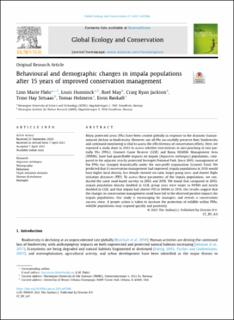| dc.contributor.author | Flølo, Linn Marie | |
| dc.contributor.author | Hunninck, Louis Marcel | |
| dc.contributor.author | May, Roelof Frans | |
| dc.contributor.author | Jackson, Craig Ryan | |
| dc.contributor.author | Setsaas, Trine Hay | |
| dc.contributor.author | Holmern, Tomas | |
| dc.contributor.author | Røskaft, Eivin | |
| dc.coverage.spatial | Serengeti, Tanzania, Africa | en_US |
| dc.date.accessioned | 2021-05-10T11:39:19Z | |
| dc.date.available | 2021-05-10T11:39:19Z | |
| dc.date.created | 2021-05-03T12:42:52Z | |
| dc.date.issued | 2021 | |
| dc.identifier.issn | 2351-9894 | |
| dc.identifier.uri | https://hdl.handle.net/11250/2754649 | |
| dc.description.abstract | Many protected areas (PAs) have been created globally in response to the dramatic human- induced decline in biodiversity. However, not all PAs successfully preserve their biodiversity and continued monitoring is vital to assess the effectiveness of conservation efforts. Here, we repeated a study done in 2003 to assess whether investments in anti-poaching in two par-tially PAs (PPAs), Grumeti Game Reserve (GGR) and Ikona Wildlife Management Area (IWMA), have had quantifiable impacts on impala (Aepyceros melampus) populations, com-pared to the adjacent strictly protected Serengeti National Park. Since 2003, management of the PPAs has changed dramatically under the non-profit organisation Grumeti Fund. We predicted that if conservation management had improved, impala populations in 2018 would have higher local density, less female-skewed sex ratio, larger group sizes, and shorter flight initiation distances (FID). To assess these parameters of the impala populations, we con-ducted the same road-based surveys in 2003 and 2018. We found that compared to 2003, impala population density doubled in GGR, group sizes were larger in IWMA and nearly doubled in GGR, and that impala had shorter FID in IWMA in 2018. Our results suggest that the changes in conservation management could have led to the observed positive impacts for impala populations. Our study is encouraging for managers and reveals a conservation success story: if proper action is taken to increase the protection of wildlife within PPAs, wildlife populations may respond quickly and positively. | en_US |
| dc.language.iso | eng | en_US |
| dc.rights | Navngivelse 4.0 Internasjonal | * |
| dc.rights.uri | http://creativecommons.org/licenses/by/4.0/deed.no | * |
| dc.subject | Aepyceros melampus | en_US |
| dc.subject | Demography | en_US |
| dc.subject | Behaviour | en_US |
| dc.subject | Flight initiation distance | en_US |
| dc.subject | Human disturbance | en_US |
| dc.subject | Serengeti | en_US |
| dc.title | Behavioural and demographic changes in impala populations after 15 years of improved conservation management | en_US |
| dc.type | Peer reviewed | en_US |
| dc.type | Journal article | en_US |
| dc.description.version | publishedVersion | en_US |
| dc.rights.holder | © 2021 The Author(s). | en_US |
| dc.subject.nsi | VDP::Zoologiske og botaniske fag: 480 | en_US |
| dc.subject.nsi | VDP::Zoology and botany: 480 | en_US |
| dc.source.volume | 27 | en_US |
| dc.source.journal | Global Ecology and Conservation | en_US |
| dc.identifier.doi | 10.1016/j.gecco.2021.e01586 | |
| dc.identifier.cristin | 1907766 | |
| dc.relation.project | EC/H2020/641918 | en_US |
| dc.source.articlenumber | e01586 | en_US |
| cristin.ispublished | true | |
| cristin.fulltext | original | |
| cristin.qualitycode | 1 | |

